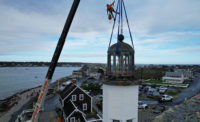Workers laser-focused on prepping a hemmed-in Seattle site for redevelopment aren’t paying attention to the project’s 850-ft-tall centerpiece—Rainier Square Tower. They may not even know that RST’s novel composite steel superstructure could serve as a model for a new generation of speedier, safer and better office tower construction—everywhere.
The shoring, demolition and excavation contractors for the mixed-use Rainier Square redevelopment have a more pressing task. Their job is to keep the bordering city streets at bay and, more critically, to keep the adjacent and occupied 514-ft-tall Rainier Tower from turning from a looming tower into a leaning tower.
The 40-story RT is the sole survivor of the city block’s 1970s Rainier Square development, which also contained two- and three-story buildings. The high-rise, with its 12-story pedestal, stands in the southeast corner of the block—too close to the RST site.
“This is the most challenging excavation we’ve done,” says John F. Kvinsland, a vice president of shoring contractor Malcolm Drilling Co.
Malcolm, Rhine Demolition and excavation subcontractor City Transfer Inc. (CTI) aren’t the only members of the RS team with eyes on 65,000-sq-ft site, as the pit deepens to 85 ft in places. Magnusson Klemencic Associates (MKA), the structural engineer for Rainier Square, is headquartered on RT’s 32nd floor.
The view out his office window is “awesome,” says MKA’s chairman and CEO Ron Klemencic—the mastermind of the radical RST superstructure. Klemencic, who has a fear of heights, has so much confidence in the excavation and shoring operations that he thinks nothing of his perch overlooking the pit.
To date, the engineer’s confidence is borne out. With 50% of the excavation complete, there has been no untoward movement of Rainier Tower’s structural concrete mat, says David G. Winter, president and CEO of the job’s geotechnical engineer, Hart Crowser (HC).
“Mat movements to date are less than 0.1 inch ... [and] we appear to be tracking close to our predictions.”
– David G. Winter, President & CEO, Hart Crowser
“Mat movements to date are less than 0.1 inch, and we think some of that is temperature related,” he says. “We appear to be tracking close to our predictions ..,” he adds.
Klemencic is even more excited about RST’s novel structure than its deep excavation—so much so that he has climbed out on a limb. MKA and the RST team predict the frame’s construction will take 40% less time than a steel frame with a leading concrete core (ENR 12/25/17-1/1/18 p. 18).
Key to the prediction is a shear-wall core consisting of sandwiches of cross-tied steel-plate modules, field filled with concrete. The system has never been used on a tower.
Designed by architect NBBJ as an office-residential-retail high-rise with seven basement levels, mostly for parking, the RST job would have been daring enough, thanks to the novel system and its proximity to RT. But the job’s challenges went from great to greater in 2014, when site core drillings turned up weak soil, called slickensided clay.
The slickenside condition was formed by Ice Age glaciers when relative movement occurred along a fracture. The site’s slickensided clay has roughly one-third the strength of normal soils in the area, says Brice Exley, HC’s project manager.
The weak clay would not be an issue were it not for the excavation that when completed at the end of July will be as much as 54 ft below RT’s mat foundation.
To keep the older tower from moving, Malcolm’s workers are installing a shoring system consisting of a 170-ft-long secant-pile wall on the south side of RST’s basement wall. The cut down to the top of the secants is up to 32.5 ft. The east-west secant wall begins at the elevation of the top surface of RT’s 12-ft-thick mat.
Parametric Study
Under contract to Rainier Square developer Wright Runstad & Co., HC did a site investigation and a geotechnical engineering analysis. Work included modeling the secant wall system.
The weak clay prompted HC to do a parametric study as part of its analysis. To simulate an array of scenarios, the engineer varied parameters, such as soil strength and modulus, the size of the wide flange (WF) steel member pile reinforcement, the strength of the concrete, the depth of piles, the length of tieback anchors—with emphasis on estimating deflections when excavators reach the ultimate base of the hole—and the eventual load transfers from the shoring to the RST’s ground slab and six elevated basement decks.
Based on its analysis, HC set the deflection limit of the secant wall, and RT’s maximum allowable settlement. RT’s 106-ft-square mat is allowed to move up to 1.5 in. vertically. The design limit on differential settlement across the mat is 1 in.
HC then provided minimum size, stiffness and geometric constraints for the structural design of the secant wall, performed by Ground Support PLLC—a subconsultant to Malcolm. Ground Support worked in close collaboration with HC, MKA, Malcolm and the job’s general contractor, Lease Crutcher Lewis.
Secant walls are formed by drilling intersecting concrete piles, each reinforced by a vertical WF member. The WF of each 93-ft-long pile, 5 ft in diameter, is encased in lean-mix concrete from the excavated ground surface to the bottom of the excavation and structural concrete down some 33 ft to the toe of each pile.
The failure surface of the weak soil extends into the deep glacial till. HC specified the composite pile for the length that extends deeper than the base of the excavation to reduce deformations and minimize the WF size.
As designed, the secant pile wall is supported laterally under RT by eight rows of a total of 262 drilled tieback anchors inclined at 17.5° and on a 4.5-ft by 5.5-ft grid along the wall. The tiebacks, as long as 135 ft, are prestressed to loads as high as 150 kips to resist RT’s surcharge loads. Until RST’s basement levels are built, the tiebacks carry all lateral loads imposed by Rainier Tower.
The rest of the site’s perimeter, including the west side of RT, is shored conventionally with soldier piles, drilled as deep as 122 ft from grade. Cuts in 6 ft lifts followed. After each cut, crews installed lagging and drilled tiebacks.
Typically, there is one tieback installed for 96 sq ft of shoring, says Malcolm’s Kvinsland. In the secant wall, there is one tieback for every 23 sq ft of shoring.
“We are trying to eliminate any chance for the slickensides to slip, and we also need to support the load from Rainier Tower,” says HC’s Winter.
To track any RT movement, HC designed an extensive monitoring system. There are a total of 380 targets on the office tower itself, the secant wall and the soldier pile shoring around the perimeter of the rest of the site. To establish a baseline for RT movement, sensors were installed on RT in advance of construction.
Tiltmeters
Tiltmeters are monitoring any deformation of RT’s mat. All data is recorded automatically and uploaded to a website. If there is 0.5 in. of recorded deflection of Rainier Tower and the secant wall, the team receives an e-mail generated from the website and HC assesses the situation. If there is 1 in. of deflection, construction would stop while “we implement a fix,” says HC’s Exley.
Work on Rainier Square, which also includes a 12-story hotel in the site’s southwest quadrant, began last fall with the near-surgical demolition of the 1970s low-rise buildings. On Jan. 18, Malcolm’s crews, using two rigs, began drilling 70- to 80-ft-deep soldier piles along the east wall, which borders a busy city street.
Timing was critical. The city had only given Malcolm 10 days for the work, which interfered with street traffic. “We finished in eight,” says Kvinsland.
Once crews had completed drilling soldier piles along the east edge of the site, Rhine and CTI, in concert, began demolishing old foundations and excavating so that Malcolm could finish the shoring system. Once the east wall was done, the drill crew moved to the southwest corner where the hotel will rise, and worked clockwise back toward the east wall.
Before work could begin on the secant pile wall, crews had to excavate 32.5 ft along the east side and install three rows of soldier-pile tiebacks and lagging on the east wall. Malcolm crews did the work in concert with demolition and mass excavation.
Work on the secant wall began in March, at the elevation of the top of the Rainier Tower mat. Crews finished the wall in 15 working days. Next, CTI crews began excavating in 5 ft lifts to allow Malcolm to drill in the tiebacks.
Coordination with Malcolm, CTI and Rhine Demolition—which kept finding more obstructions—was critical. “In general, it was a complicated demolition, shoring and earthwork sequence and the contractors needed to work in concert” more than is usual, says Shannon Testa, LCL’s senior project manager.
“Though the work was well orchestrated, it was challenging to be productive in such an urban environment,” adds Kvinsland. “I am surprised by the intense coordination but am happy where we are now.”
Material was crushed, placed in the center of the site and conveyed out. “Crews were working the shoring and removing material from the middle at the same time,” says Keith Benson, CTI’s president.
All tiebacks, on course for completion next month, are roughly 50% complete. The excavation also is 50% complete. CTI will have removed 135,000 cu yd of material when it finishes work late next month.
“We are through the hard stuff and into production excavation and tieback installation,” says Testa.
Though the operations are going well, there was a hiccup. Early on, crews encountered more water than anticipated in the area of the site’s northeast corner. They had to install a system of deep wells.
Construction of RST’s mat foundation will follow after the excavation is complete. The mat is scheduled to be finished in August. In September, The Erection Co. expects to begin work on the novel superstructure. The entire project is scheduled to be completed during the spring of 2020.
“Watching the excavation get deeper and deeper is exciting,” says MKA’s Klemencic. “In my wildest dreams, I never thought I would look out my office window and get such a thrill.”















Post a comment to this article
Report Abusive Comment